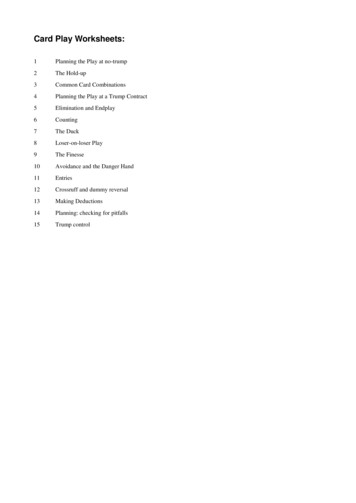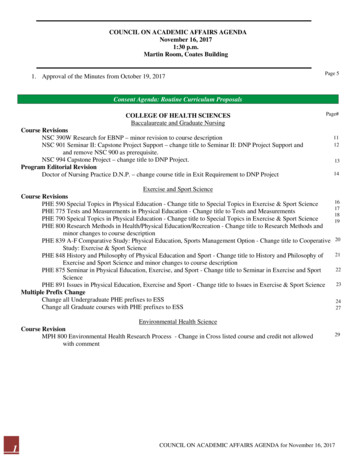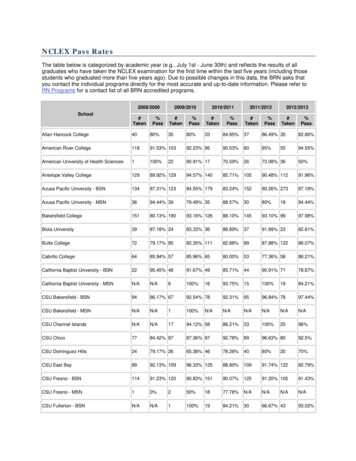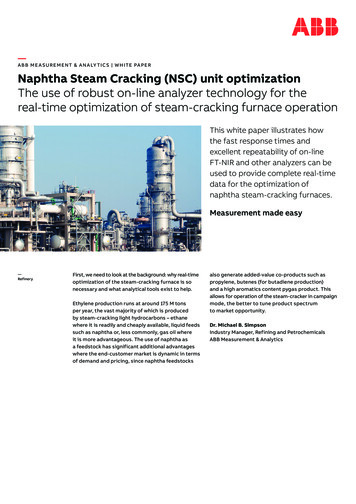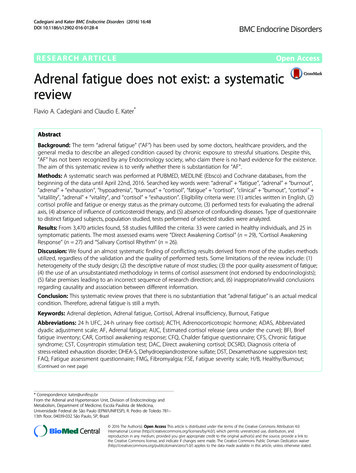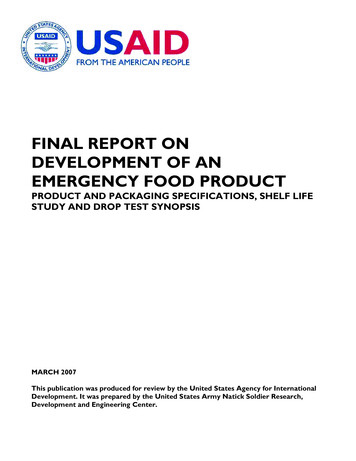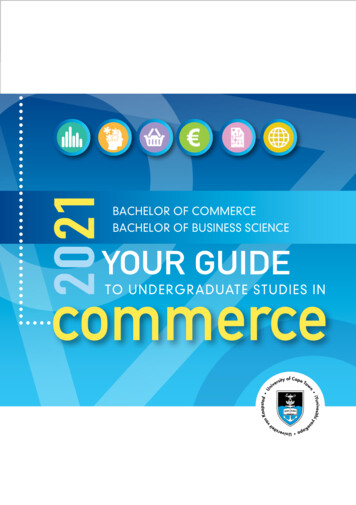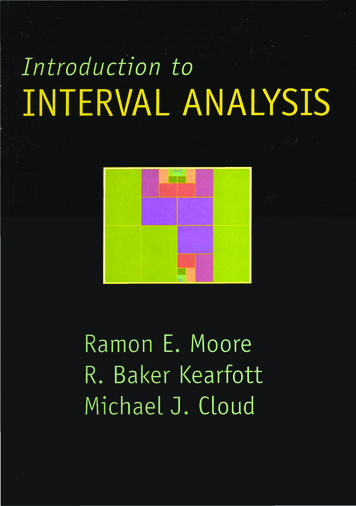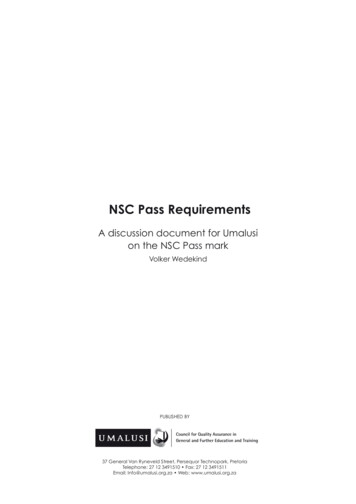
Transcription
NSC Pass RequirementsA discussion document for Umalusion the NSC Pass markVolker WedekindPUBLISHED BY37 General Van Ryneveld Street, Persequor Technopark, PretoriaTelephone: 27 12 3491510 Fax: 27 12 3491511Email: Info@umalusi.org.za Web: www.umalusi.org.za
EDUCATIONALL RIGHTS RESERVEDCOUNCILINGENERALANDTRAINING
Table of ContentsEXECUTIVE SUMMARY. . . . . . . . . . . . . . . . . . . . . . . . . . . . . . . . . . . . . . . . . . . . . . . . . . . . . . . . . . . . . 1INTRODUCTION . . . . . . . . . . . . . . . . . . . . . . . . . . . . . . . . . . . . . . . . . . . . . . . . . . . . . . . . . . . . . . . . . . 3HISTORICAL BACKGROUND . . . . . . . . . . . . . . . . . . . . . . . . . . . . . . . . . . . . . . . . . . . . . . . . . . . . . . . . 5THE CURRENT SITUATION. . . . . . . . . . . . . . . . . . . . . . . . . . . . . . . . . . . . . . . . . . . . . . . . . . . . . . . . . . 11THE RECEPTION OF THE NSC. . . . . . . . . . . . . . . . . . . . . . . . . . . . . . . . . . . . . . . . . . . . . . . . . . . . 11.WHAT IS THE PURPOSE OF THE NATIONAL SENIOR CERTIFICATE? . . . . . . . . . . . . . . . . . . . . . . 12INTERNATIONAL COMPARISONS. . . . . . . . . . . . . . . . . . . . . . . . . . . . . . . . . . . . . . . . . . . . . . . . . . . 18INTERNATIONAL EXAMINING BODIES. . . . . . . . . . . . . . . . . . . . . . . . . . . . . . . . . . . . . . . . . . . . . 18Cambridge International Examination . . . . . . . . . . . . . . . . . . . . . . . . . . . . . . . . . . . . . . . 18.International Baccalaureate. . . . . . . . . . . . . . . . . . . . . . . . . . . . . . . . . . . . . . . . . . . . . . . . 19NATIONAL EXAMINING AUTHORITIES. . . . . . . . . . . . . . . . . . . . . . . . . . . . . . . . . . . . . . . . . . . . . 21Brazil. . . . . . . . . . . . . . . . . . . . . . . . . . . . . . . . . . . . . . . . . . . . . . . . . . . . . . . . . . . . . . . . . . . . 21Kenya. . . . . . . . . . . . . . . . . . . . . . . . . . . . . . . . . . . . . . . . . . . . . . . . . . . . . . . . . . . . . . . . . . . 22Botswana. . . . . . . . . . . . . . . . . . . . . . . . . . . . . . . . . . . . . . . . . . . . . . . . . . . . . . . . . . . . . . . . 23Singapore . . . . . . . . . . . . . . . . . . . . . . . . . . . . . . . . . . . . . . . . . . . . . . . . . . . . . . . . . . . . . . . 24Tanzania. . . . . . . . . . . . . . . . . . . . . . . . . . . . . . . . . . . . . . . . . . . . . . . . . . . . . . . . . . . . . . . . . 24Australia. . . . . . . . . . . . . . . . . . . . . . . . . . . . . . . . . . . . . . . . . . . . . . . . . . . . . . . . . . . . . . . . . 24.Norway. . . . . . . . . . . . . . . . . . . . . . . . . . . . . . . . . . . . . . . . . . . . . . . . . . . . . . . . . . . . . . . . . . 25CONCLUSION . . . . . . . . . . . . . . . . . . . . . . . . . . . . . . . . . . . . . . . . . . . . . . . . . . . . . . . . . . . . . . . 25RECOMMENDATIONS. . . . . . . . . . . . . . . . . . . . . . . . . . . . . . . . . . . . . . . . . . . . . . . . . . . . . . . . . . . . 27CONCLUSION. . . . . . . . . . . . . . . . . . . . . . . . . . . . . . . . . . . . . . . . . . . . . . . . . . . . . . . . . . . . . . . . . . 31REFERENCES . . . . . . . . . . . . . . . . . . . . . . . . . . . . . . . . . . . . . . . . . . . . . . . . . . . . . . . . . . . . . . . . . . . 33ii
Executive SummaryA number of commentators have raised concerns about the pass mark requirements set forthe National Senior Certificate (NSC) qualification within the context of wider concerns aboutthe quality of the schooling system. There is a perception that the pass mark is 30% and thatthis is too low, either because it signals that learners have only mastered 30% of the material,that the expectations are lower than they used to be, or that low minimum pass marks set lowexpectations. This discussion paper seeks to interrogate these concerns and explore possibleways of addressing these concerns. It notes that changing the pass mark does not addressfundamental concerns about quality which can only be addressed in terms of the quality ofteachers, the materials, the curriculum documents and assessment systems.The paper is a discussion document. It draws on limited desktop research and somemanipulation of statistical records. It begins by exploring the historical background to theNSC by examining what the ‘historical future’ of the NSC policymakers was. This refers to theimagined future educational landscape that was envisaged when the policy was written.This imagined future located the NSC as a primarily academic and specialized qualificationalongside more vocationally oriented alternatives for post-compulsory, post-generaleducation learners. As the policy was put into practice this imagined future transformed intothe reality that the NSC, like its predecessor the Senior Certificate, was the main exit pointfrom the schooling system. Despite public perception, the structure of the of the old SeniorCertificate set the pass marks for subjects at similar and even lower levels than the NSC,particularly by converting failure at one level into a pass at Standard Grade or Lower Grade.Given the de facto role that the NSC plays as the main exit point from the schooling system,it is necessary to understand what role it should play, and what the patterns of achievementare that influence learner pathways and destinations. Drawing on a Systems Heuristicapproach, four broad groups are identified with an interest in the NSC. The learners (andtheir families) need both a certificate of completion and a record of achievement thatsignals something about what the learner is capable of going forward. The ‘clients’ are theemployers and the post-school educational institutions which seek to recruit the learners andwant a mechanism that differentiates the applicants and allows for selection into differentjobs or learning programmes on the basis of reliable indicators of future success. The decisionmakers include politicians and civil servants who have political or personal accountabilityand have the authority to allocate resources. Their concerns are usually focused onmanaging perceptions and meeting targets such as pass rates at a macro level. The fourthgrouping are the professionals and experts whose livelihoods are dependent on the system.Each group, and within each group, represents distinct interests that can be at odds witheach other, and the system has to find ways of balancing the demands.Currently about three quarters of the candidates who pass the exam achieve a pass thatprovides access to diploma and degree programmes offered by universities, while very fewcandidates achieve the minimal pass. The school leavers need to be accommodated acrossa spectrum of post-school institutions including, but not predominantly, at universities. Yetmuch of the current focus of the debate has been shaped by the NSC graduates’ success atuniversity level programmes. The NSC must of necessity fulfil a range of purposes.Whether the NSC is out of alignment with international norms is addressed through a desktopreview of pass requirements of two international systems (the Cambridge International1
Examination and the International Baccalaureate) and seven selected countries that havedifferent systems to South Africa. The conclusion that emerges from this is that, while it isproblematic to compare systems, there are a number of countries that set their pass marks atthe same or even lower levels. The suggestion that 50% is the norm internationally is not borneout by the survey.The final part of the paper explores three scenarios by examining their effect on pass rates ofthe 2008-2011 cohorts of learners. The first scenario sets the pass requirement at a minimum of50% per subject written. This would have a major effect reducing the pass rate to around 10%.The second scenario explores the effect that a requirement that students should achieve a50% aggregate. Here the pass rate moves up to about 40%. Neither option is deemed realisticgiven the general concerns about pass rates. A third scenario is based on a strengtheningof the routes into higher education programmes by focusing on the requirements for thelanguage of learning and teaching (LOLT) which is currently set at 30%. Research on studentsuccess at university suggests that achievement in the LOLT is a good indicator of successin higher education programmes. If this were raised to 50% for the Diploma and Bachelorspass and to 40% for the Higher Certificate pass there would be no impact on the overall passrate, but some re-categorisation of passes within the NSC. If this were coupled with improvingstandards in the examination, and a much clearer reporting of the category of NSC pass,the effect could be positive at a symbolic level (with a 50% aggregate being a viablerequirement), may provide clearer signals to employers, education providers and students,without generating public hysteria about drops in the overall pass rate.The paper concludes with recommending the third scenario (or a variation of it) subject tofurther interrogation of the data and further research.2
IntroductionThis report interrogates the appropriateness or otherwise of the pass levels set for the NationalSenior Certificate (NSC). During the course of 2012 a number of high profile commentatorshave criticized the level of achievement required by learners to pass the NSC examinationsand this generated vigorous, though often misinformed, public debate about standards.Umalusi, as the quality assurance and standards authority responsible for the schoolingsystem, responded to the debate by correcting some of the inaccuracies, but also bycommissioning research into this topic. This discussion paper1 constitutes a component of theUmalusi response, and attempts to provide some comparative basis for making suggestionsto the Minister for adjustments to the NSC pass requirements. It is noted that Umalusi does nothave the authority to make the changes, and this report therefore can only form the basis forproposals. Nevertheless, given Umalusi’s statutory responsibilities, it is entirely appropriate forUmalusi to interrogate the issues under review.Boltanski and Thévenot (2006) describe critique as a contestation of ideas where the criticsposition themselves by appealing to a range of principles that are often incommensurableor at least based on different logics. Thus when one critic argues that the pass mark isunacceptable, one must understand what discursive rules are being drawn on to make thisargument. Equally, when Umalusi responds, it does not necessarily draw on the same set ofconcerns. There is little scope for an objective resolution to the argument based on empiricalfact. Rather, data will be employed (or ignored) by all parties to bolster their specificargument.This paper does not seek to respond to the critiques that have been raised in order todismiss them. Rather, what is attempted is to take seriously the various arguments and tolook for pragmatic strategies that address aspects of the critique in order to bring aboutimprovement. Underpinning this approach is an understanding of the complexity of socialsystems, and the inability to fully predict the consequences of reforms (Ramalinga et al 2008).Thus, the adjustments proposed at the end of this paper are deliberately limited so that thesystem is not unduly shocked by major revisions and that continuities are recognized andunderstood.The overarching approach taken in this report is to attempt to answer the questions: Whatpurpose does the National Senior Certificate serve? In what ways does the pass requirementserve that purpose? How can the current situation be improved?In order to move towards answering these questions the paper begins by revisiting the‘historical future’, i.e. the imagined future envisaged by policymakers at the time of thedevelopment of the NSC. This is done by sketching in broad strokes the history of thedevelopment of the policy that governs the NSC, and how this has unfolded over time.This paper is not a research report. It is a discussion paper that tries to open up a debatedrawing on basic desktop research, some manipulation of statistical data to explorescenarios. The views are the author’s and do not reflect an official Umalusi position. My thanksto Emmanuel Sibanda, Gerhard Booyse and Paul Mokilane for assistance with the scenarios.13
This is followed by a discussion of the key trends in the current context, and what the majorfault lines associated with the NSC are. In order to place the NSC in an international contextand to unpack some of the claims made by critics of the current requirement, the paperreviews a selected group of international examination systems.On the basis of the historical review and the international comparison, three scenariosin which the pass requirements are changed are explored by examining their effect onthe 2008-2011 cohorts. A recommendation for an adjustment is proposed. The conclusionrecommends further research to inform the decision.4
Historical BackgroundIt is not possible to provide a full overview of the history of the final school leavingexaminations within the limitations of this report, but it is important to draw out some of thekey strands of that history. This is important because it contextualizes some of the currentissues, and because one of the dimensions of the critique has invoked a logic that arguesthat examination systems in the past were setting higher standards and that the markrequired to pass was historically higher than it is today.When reference is made to the apartheid education system or its components, ChristianNational Education and Bantu Education, these overarching terms capture in broad strokesa history of systematic discrimination based on a racist ideology. However, what these termsmask is the complexity of that system and the fact that there was significant variation at arange of levels. At its height the system was comprised of four provincial departments dealingwith education for whites, separate authorities for Indians (House of Delegates), coloureds(House of Representatives) and African blacks outside the homelands (DET), as well asseparate departments of education in the ‘self-governing homelands’ (KwaZulu, Qwaqwa,KwaNdebele, etc) and the ‘independent’ TBVC (Transkei, Bophuthatswana, Venda andCiskei). In all there were 17 different departments each administering their own examinationsand, in some cases, following divergent curricula and assessment regimes.While there was sufficient commonality across the systems in the overarching curriculumand assessment structure (similar subject choices, rules of combination, broad syllabuscongruence) to allow for a fairly quick merger after 1994, this superstructural congruencemasked the fact that quite different practices had developed within the various substructuresof the education system. To date there has not been a systematic examination of standardsacross different examining bodies of the apartheid system, but there is anecdotal evidenceof quite significant variation in the nature of tasks set2. Thus, when people compare with thepast, it is not always clear which part of the past is being invoked.While there was variation in terms of standards, the qualification requirements were constantacross the system and the old Senior Certificate had the same pass requirements in termsof marks. What distinguished it from the current system was the fact that three internallevels were allowed – Higher Grade, Standard Grade and Lower Grade (the latter beinga technical conversion rather than a separate syllabus and examination) and that thepass was determined by an aggregate. Thus, comparison with the past is problematic inso far as the old system comprised complex rules of passes at different levels. In addition toincluding subject passes at different grade levels, the old senior certificate made provisionfor the inclusion of some technical subjects on the NATED 190/191 subject list which furthercomplicates a comparison. The table below summarises the main features of the twocategories of pass.For example, in history the Natal Education Department had already adopted a skills-basedapproach while the DET and Transvaal Education Department (TED) were assessing recall ofcontent.25
Senior CertificateSenior Certificate with endorsement6 subjects offered and written fromregistered SC subjects.6 subjects offered and written fromregistered SC subjects.Pass 5 subjectsPass 5 subjectsOne official language and one language oflearning and teaching20% sub-minimum in 6th subjectMinimum aggregate of 720 marksMinimum aggregate 950 marksHG subjects failed with between 25% and39% convert to SG passesMust present subjects from Group A andthree of Groups B to FSG subjects failed with between 25% and33% convert to LG passes2 Official languages to be offered andpassed at First and Second LanguageHG level. One of two languages to be auniversity language of instructionConcession for immigrants – 6 subjects,including one official First LanguageSubjects passed from Group A and three ofGroups B to F OR subjects from Group A andtwo of Groups B to F where a second GroupC or Group E subject pass compensates fora pass from a fourth groupCondonation of 2% for a pass or 10 marks onthe aggregate and conversions allowedOnly HG failures of between 30% to 39%converted to SG passesSC can be obtained with inclusion of N3subjects187 senior certificate subjects recognised forendorsementLower Grade subjects – only for conversionpurposesCondonation of 2 % for a pass or 10 marks onthe aggregate and conversions allowedConcession to immigrants – 6 subjects, twolanguages – second official language canbe SG or HG Group D or A-level languageThe second aspect of the history of the school exit examination relates to the multiplepurposes of that examination. Prior to the introduction of the National QualificationFramework, the Senior Certificate was a crossroad in an individual’s educational career. Onecritical function that it fulfilled was that it was recognised by the Joint Matriculation Board(JMB), a sub-structure of the South African Universities Vice-Chancellors Association (SAUVCA– now Higher Education South Africa), that administered the university entrance processes.It is not commonly understood that ‘matriculation’ is in fact the process of enrolling into aninstitution (usually a university) and that universities have the right to set their own entranceexamination, known as a matriculation examination. The JMB recognised that certaincategories of pass in the Senior Certificate could exempt people from the requirement towrite a matriculation examination, and hence they would award people with what becameknown as the ‘matric exemption’.3 In reality South African universities did not set their ownmatriculation tests and consequently the concept of ‘exemption’ lost some of its originalmeaning4. So strong was the emphasis on getting the exemption that over time the wholeassessment became known as matric exams and the final year of schooling became knownin most schools as Matric.There are other ways to be exempted from this requirement such as mature age or otherexamination systems.4This interpretation was disputed by a senior official at HESA and needs to be historicallyverified. It does not change the substance of the argument and the recommendationsmade.36
This issue of the ‘Matric’ and all that it carries discursively is more than just semantics. Whatit signals is that the school leaving certificate had become strongly associated with onefunction, namely providing access into university level programmes. Of course, historicallyand to date, a relatively small (albeit growing) proportion of school leavers actually proceedinto degree level programmes. The majority of school leavers either enter into vocationallyoriented certificate and diploma programmes at public and private colleges or universities oftechnology (formerly technikons) or they enter directly into the labour market (or sadly, noneof the above). Thus the certificate had to signal something about the recipient to a range ofeducational providers at different levels with different purposes as well as to employers andthe general public. The multiple versions of passes that were possible under the old SeniorCertificate allowed for a much greater differentiation amongst the holders of the certificatedependent on whether the learner had higher or standard grade subjects, and whether thecombination of subjects included vocational N1-N3 subjects. The question arises again: If oneis comparing with the past, what is it that is being compared?Bill Green has recently pointed to the need for researchers to better understand the ‘historicalfuture’ (Green 2012). What he means is that we need to understand not only what happenedhistorically, but also what people were imagining their future to be. Thus, in examining thehistory of the NSC, we must also understand what future the policymakers of the 1990s wereworking towards, even if that is not what transpired. The introduction of a Further Educationand Training Certificate (FETC) was the original vision for the exit point at the end of bothschools, FET colleges and workplace training. The intention, articulated in the Green Paperon Further Education and Training, was for a post-compulsory Further Education system (theFET Band) comprising schools that focused on an academic track leading in the main touniversity entrance, colleges (both public and private) that focused on a general vocationalpathway, and work-based learning linked to specific trades and occupations. All threepathways would ultimately lead to the same qualification (an FETC). It was anticipated thatthe majority of learners (as they were now called) would be found in the vocational streams,as the academic track leading to university entrance would cater for a relatively smallersegment of the learner population.UniversitiesUniversities C (now NSC andNCV)Grades 10-12 inSchoolsFET CollegesWorkplaceUmalusiFurtherEducation andTrainingGETC (GEC)ABET CertificatesGeneralEducation andTrainingSchoolsGrade R – 9ABET Levels 1 – 47
There are some parallels in this envisaged system with the FE system in the UK, or thedifferentiation between Grammar and Comprehensive schools, or indeed the distinctionbetween Gymnasium and Volkschule in the Germanic system. The one pathway providesan academic preparation for university while the majority receive a rounded education thatprepares people for work directly or for further vocationally oriented study. Because the NQFmade provision for both recognition of prior learning (RPL) and transfer of credits horizontallyand vertically, the pathways outlined in the policy were not intended to be terminal orrestrictive. In this imagined future a learner could complete Grade 9 (the end of the GeneralEducation band), proceed to a college and work toward a vocational FETC, transfer creditsand return to schools in order to gain access to university and so forth.Very little of this vision actually materialized. The notion of Grade 9 being an exit point fromthe system was never developed seriously. Because of resource constraints, colleges werenot expanded or reconceptualised in the manner envisaged in the Green Paper, wherethey would accommodate the majority of mainstream learners. The National Certificate(Vocational) was not developed in conjunction with the NSC. Schools remained the institutionof choice (or necessity) for more than 90% of learners enrolled in the FET Band. However, thecurriculum that was developed for the FET schools did adopt certain of the assumptions of theimagined future system. The accommodation of vocational subjects from NATED 190 withinthe structure of the NSC qualification was removed, initially vocationally oriented schoolsubjects were removed (on the assumption that these would now be offered at colleges),and the need for standard and lower grade were removed because the learners that theseprovisions catered for would not be in the academic stream. In addition gateway academicsubjects such as Mathematics were made compulsory (with the introduction of MathematicalLiteracy as an alternative for those not planning to enter science and commerce streams atuniversity5).The structure of the envisaged qualification signalled that it was already a specializedcurriculum, rather than a general or comprehensive one, in that learners were expectedto select subjects within a specific learning field, so that their FETC would have a degreeof specialisation. This was based on the notion that a post-general education should bespecialized, and that all qualifications at this level should specify fundamental, core andelective components. The fundamental component included Life Orientation, while the corecomprised Language and Mathematics and the elective was made up of a selection ofthree subjects, two of which had to be in the same learning field. For example, learners wouldbe required to choose their packages with a science, languages, or agricultural studiesorientation. This requirement was only changed days before the rules of combination weregazetted on the advice of a ministerial committee that suggested that these combinationswere not workable in many schools.The original intention was that Mathematical Literacy would be a requirement for all learnersalongside Life Orientation regardless of whether the learner selected Mathematics as asubject.58
NCS Subjects– Agriculture Agricultral management practices*, Agricultural science, Agriculturaltechnology*– Arts and Culture Dance studies, Design, Dramatic Arts, Music Visual Arts– Business, Commerce and Management Studies Accounting, Business Studies, Economics– Engineering and Technology Civil technology*, Electrical technology*, Mechanical technology*, Engineeringgraphics and design*– Services Consumer Studies, Hospitality Studies, Tourism– Languages All SA languages at 2AL and many foreign languages– Human and Social Sciences Geography, History, Religion Studies– Physical, Mathematical, Computer and Life Sciences Computer Applications Technology, Information Technology, Life Science,Physical ScienceWhile practical implementation issues shifted the rules of combination in a way that madethe structure relatively flexible, the teams that had developed the curriculum statements hadworked with a notion of the curriculum being targeted at an academic stream. For exampleit was assumed that technical subjects would now be accommodated in colleges and thatthere was thus no need for subjects traditionally taught in technical high schools. This wasalso revised to a degree at the time of implementation, and a number of the technical andvocationally oriented subjects were not available or in draft form when the curriculum wasimplemented. (See the subjects in bold italics in the box above.)9
When the new National Senior Certificate6 was gazetted in 2005 the final structure wasthe outcome of a number of compromises and debates about what was and was notappropriate for the qualification. Various lobby groups applied pressure to influence theinclusion of specific subjects and there were major debates about the nature of the proposedMathematical Literacy subject7.The final outcome, gazetted in July 2005, resulted in a qualification which demonstratedsufficient continuity with the structure of the Senior Certificate, while introducing twokey features that were new. Firstly, there was more specification of subjects through therequirement that all learners take two languages, that all learners take either Mathematicsor Mathematical Literacy and that all learners take Life Orientation. Secondly, the distinctionbetween Higher Grade, Standard Grade and the conversion to Lower Grade was doneaway with. In addition, most subjects were significantly revised, renamed or removed. Thesechanges caused much anxiety amongst teachers and officials with concerns about systempreparedness. In terms of the assessment structure, there was concern about the impactof doing away with the different Grades, and about the weight allocated to school basedassessment8 (SBA).This brief history is important primarily in order to show that the ‘historical future’ imagined inthe policy and the curriculum statement was quite different to what eventually unfolded.There was no significant simultaneous expansion of the FET college sector as a viablealternative to high schools, and the full time vocationally oriented qualification, the NationalCertificate (Vocational) (NCV) was only developed some years later. Schools remained thei
the 2008-2011 cohorts of learners. The first scenario sets the pass requirement at a minimum of 50% per subject written. This would have a major effect reducing the pass rate to around 10%. The second scenario explores the effect that a requirement that students should achieve a 50% aggregate. Here the pass rate moves up to about 40%.
